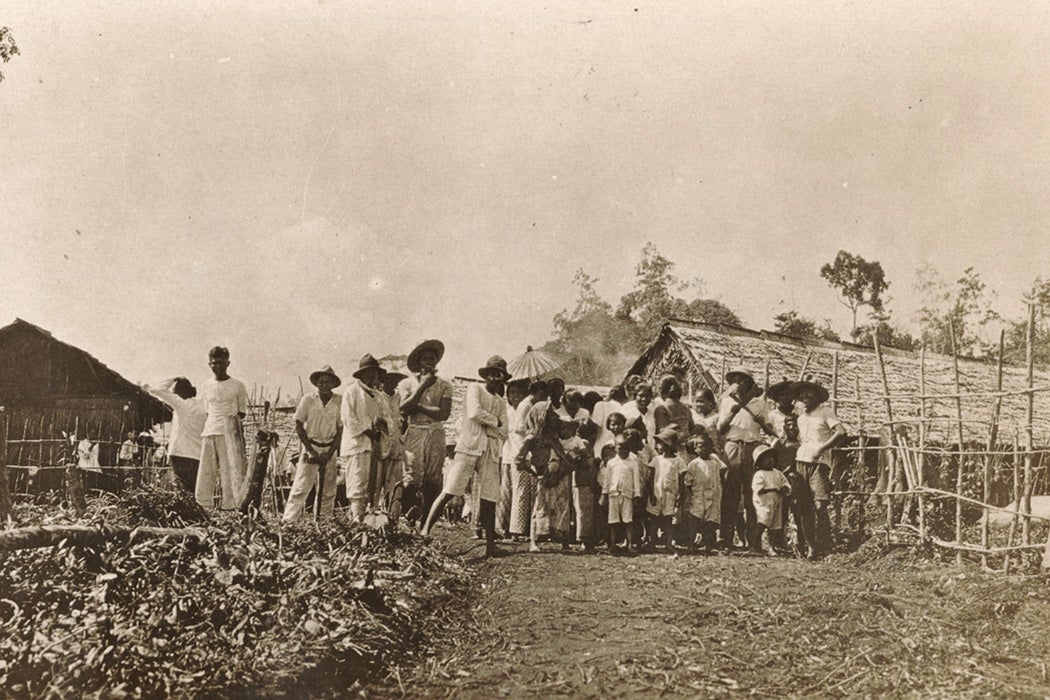In late 1926 and early 1927, communists launched anti-colonial uprisings across Java and Sumatra in the Dutch East Indies. In response, the colonial authorities opened Boven Digoel—a remote prison camp in the jungle of New Guinea, later to be known as “the Siberia of Indonesia.”
Just ten of its 1,300 prisoners in the late 1920s were ethnic Chinese—a tiny proportion that makes Digoel-themed novels by Chinese authors “all the more extraordinary,” according to Elizabeth Chandra, who calls for scholars to pay more attention to these works.
Besides Kwee Tek Hoa’s Drama di Boven Digoel (Drama in Boven Digoel), “Chinese authors generally do not figure in discussions concerning literature on Digoel,” writes Chandra. Turning to the rare Chinese-written Malay-language texts that describe Digoel exiles, she muses,
The existence of these novels and their varied perspectives on political activism compel one to ask: what exactly had motivated their creation? What do their variations (and similarities) tell us? And what can we infer about the place of ethnic Chinese authors in the (re)construction of Indonesian history?
Chandra notes that Drama—first serialized between 1928 and 1932, “at the height of the colonial communist purge”—has had the greatest longevity, returning to circulation in the early 2000s. Clocking in at an epic fifty-eight chapters, Drama is a door-stopper that follows two star-crossed young lovers: Moestari, a government official with roots in the native aristocracy, and the progressive schoolteacher Noerani, who accompanies her communist father into exile in Digoel.
“Though the writing of Drama was motivated by the internment in Digoel, and the sequence of events and technical details related are relatively accurate, it would be a stretch to identify this novel as a Digoel literature,” Chandra comments.
Kwee acknowledged that the title’s allusion to Boven Digoel was “only to create sensation,” and the heroic Moestari and Noerani are portrayed as staunch anti-communists.
“Ultimately Kwee was cautious in making reference to communism at a time when the anti-communist campaign was at its peak,” Chandra writes. “In the novel, not only the communists are depicted as uninformed and misguided, the government is said to be treating them sufficiently well.”
But the climate had shifted by 1937, when Liem Khing Hoo published Merah (Red).
“[T]he Digoel project was being reassessed,” writes Chandra. “The political environment become more conducive to sympathetic writings of labour struggle, so long as the villain was not the government.”
Merah’s hero, Soebagia, is another idealistic aristocrat. He champions better conditions for a group of cigarette factory workers who are being “treat[ed]…like machines, and give[n] rations appropriate for dogs and lodgings comparable to cow barns.” Unaligned with communism, Soebagia in fact rejects party membership. But he’s falsely accused and exiled in a scheme to break off his relationship with the local ruler’s daughter Tirtaningsih.
“Such a thing is known to have actually occurred in many instances, where local officials used the statewide communist purge as an opportunity to settle personal vendettas,” Chandra explains.
Eventually, Tirtaningsih shows up in Digoel, and the story concludes romantically. Yet Chandra believes Merah is not “just another conventional romance story” with Digoel as mere backdrop. In the novel,
the factory workers are not glossed over as a nameless mass… Readers also get a glimpse of the workers’ daily existence and challenges such as housing, low wage, layoff, bad health, and debts—something uncommon in contemporary popular literature.
Liem even describes Digoel using the same term—“hell” (neraka)—earlier applied to the cigarette factory.
The third novel Chandra excavates is Taufan gila(Mad Typhoon), released in 1950 by Liem’s acquaintance and longtime literary collaborator, Njoo Cheong Seng.
Published “at the cusp of Indonesia’s de facto independence” and a time “when socialism in the arts was on the rise,” Taufan gila is based on the experience of Njoo’s friend, a communist named Ishaka Daeng Talli who was interned in Digoel from 1927 to 1932. Chandra places the novel “among the most profound Njoo has ever written,” which she attributes to his artistic maturity, “as well as the momentous political change that took place in the 1940s.”
Weekly Newsletter
“It is precisely this spotlighting of a self-identified communist that sets Taufan gila apart from Merah and Drama di Boven Digoel,” she writes. Since Taufan gila was published after Indonesia had declared independence, “Njoo had the freedom, which Liem and Kwee did not have, to give an uninhibited accounting of how the colonial government dealt with communist activists in response to the 1926–1927 revolts,” she adds.
Nonetheless, Chandra finds merit in reading all three authors’ literary accounts of Digoel. Unlike counterparts who wrote under the auspices of the colonial state publishing house, Indies Chinese authors “had more liberty to write about politically sensitive matters, including the communist revolt, even if they had to absolve the government of blame, as Liem did in Merah.”
“Sino-Malay literature remains an understudied field and a vast archival vault that is largely untapped,” Chandra argues, adding that “[a]ll available sources must be exhausted.”







